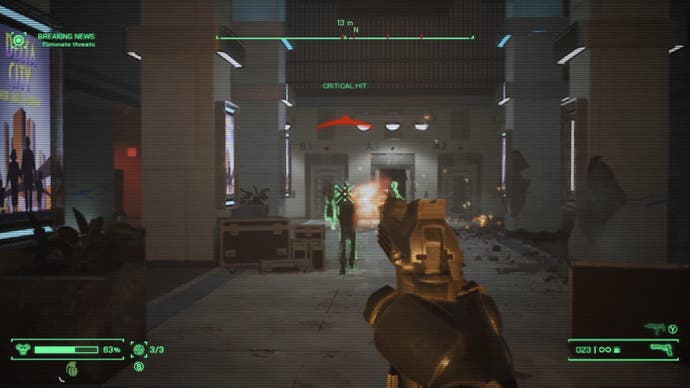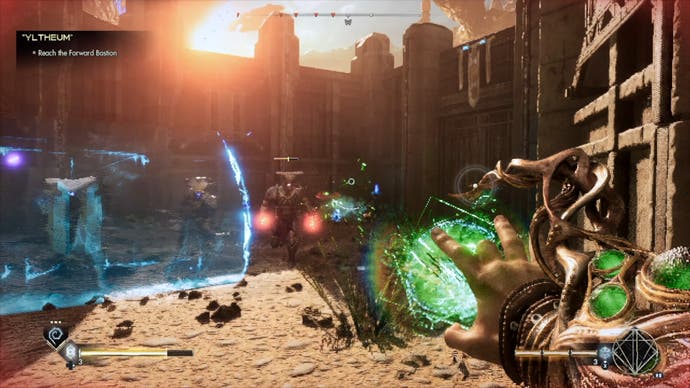
Epic’s Unreal Engine 5 is swiftly changing into the engine of selection for present technology gaming. It isn’t laborious to see why: it combines ease of use and suppleness with a number of the most superior rendering tech within the trade, particularly with its Lumen and Nanite programs. On the identical time, that sophistication poses a problem for lower-power platforms, which frequently aren’t the goal for Unreal Engine 5 initiatives – and that extends to Valve’s Steam Deck.
The Linux-powered moveable powerhouse is able to some spectacular feats, however extra superior titles usually do not scale effectively to the system. So is Unreal Engine 5 a bridge too far for the diminutive handheld or does Epic’s boundary-pushing tech scale down higher than you may anticipate?
As of early 2024, we’ve got a pleasant number of early UE5 software program to check out – principally lower-budget efforts, however with some very enticing entries as effectively. A few of these video games have been even included in our greatest graphics of the yr dialogue again a couple of weeks in the past, with some critically spectacular visuals on show. However are they ‘too huge’ for Steam Deck? In our checks, we wished to maintain the video games’ visible character intact, whereas nonetheless aiming for 30fps or higher efficiency ranges.
RoboCop: Rogue Metropolis might be the flag-bearer of the present UE5 third get together titles, with excellent lighting and a eager use of key UE5 options. Settings-wise, I settled on the medium preset, with TSR at 50 p.c decision scale with a 720p output decision. TSR – or temporal tremendous decision – truly does a reasonably respectable job right here at cleansing up the picture and protecting it presentable, particularly on the interior show. We have in contrast TSR vs FSR 2 on this recreation up to now, however suffice to say that Epic’s homegrown upscaling expertise turns in a lot better outcomes right here.
The medium settings principally ship a superb expertise, however identical to on Collection S, they lack Lumen reflections. Turning the reflection technique from SSR to Lumen prices us about 7fps our favoured ‘ally with a big puddle’ take a look at scene, which goes to harm in larger-scale shoot-outs, so I opted to stay with SSR. Total, the visible outcomes right here look advantageous, however some scenes show very distracting Lumen GI noise patterns. There’s simply not sufficient decision right here to get fairly clear real-time international illumination in a variety of circumstances, and the result’s glitchy-looking picture instability. Some not directly lit areas look respectable, however many don’t.
Thankfully, these visible concessions do enable us to hit fairly respectable efficiency figures. Gameplay is usually north of 30fps with these settings, with stable frame-rates in space traversal and fight alike. Throughout extra intense fight moments, we hover someplace simply above 30fps, with extra sedate moments bringing a substantial frame-rate uplift to the 40s and 50s. There are nonetheless points with higher-latency frames, as 50ms frames are sprinkled into the combination now and again, and there are nonetheless the identical traversal stutter issues in the identical areas because the console code. Total although, I am fairly happy with the efficiency degree – simply take into account that the efficiency figures for a Steam Deck OLED operating at 90Hz on the interior show with a 30fps cap will current in another way to 30fps on the LCD Deck, with larger latency on the older mannequin.

Total, I believe RoboCop presents a combined, however considerably constructive impression of Unreal Engine 5 on Valve’s Linux-based handheld. In the event you ignore a number of the Lumen artifacts, this title presents a similar-to-console visible expertise, and the efficiency, whereas effectively wanting 60fps, remains to be ok to offer a good sufficient 30fps trip.
Immortals of Aveum follows the identical template as RoboCop. The settings menu is a bit unconventional right here, so settled on low settings as there is no such thing as a medium or equal preset. I dialled up texture decision to excessive, as a result of it would not appear to hold a efficiency penalty, and international illumination to excessive, to offer us a console-like Lumen GI presentation. I’ve pegged the decision to 720p, with FSR 2 in efficiency mode to hopefully give us a manageable efficiency degree. There isn’t any possibility for TSR sadly within the choices menu, so we’re left with a considerably artifact-ridden FSR resolve. PC UE5 builders: should you’re supporting FSR 2, please embody TSR too!
Comparisons in opposition to the Collection S console code are fascinating. The Steam Deck is not delivering gorgeous visuals, however it appears to be like higher a variety of the time than Microsoft’s junior ninth-gen console. The Collection S appears to be like delicate and low-detail compared, with muddy texture-work, restricted LODs, and lacking floor litter. The Lumen GI is noticeably pared-back although vs Collection S, although this is applicable to each Deck and the junior Xbox. Immortals’ use of Lumen is probably lower than the identical commonplace as RoboCop – however the Steam Deck has a a lot fainter impression of that lighting element. On the plus facet although, I did not normally discover a lot boiling or flickering within the Deck’s Lumen presentation.

We’re a well-recognized just-north-of-30fps expertise right here, with frame-rates usually within the 30fps to 40fps area throughout typical play. There are extra frequent 50ms frames right here although, which might breach a 30fps frame-rate cap. I seen some traversal stutters on occasion, like many UE5 titles, which once more are extra frequent right here than in RoboCop. For a conveyable expertise with arguably superior-to-console visuals, the efficiency readout right here is respectable sufficient, if barely unsteady on the margins.
Let’s take a little bit of a left flip and have a look at Jusant, Do not Nod’s mountain climbing journey. I’ve dialled in excessive settings throughout the board to offer us a usually console-level visible expertise. Wanting on the Collection S code, the advantageous lighting element of that model is missing, however the recreation appears to be like fairly related on the entire. Lumen GI is comparable sufficient, and digital shadow maps make an look right here, simply at a noticeably decrease decision. Picture high quality is fairly good, although a step down from consoles.
There is a selection of FSR 2 and TSR on this recreation, however one thing’s up with the TSR, as on the minimal level on the slider at 720p output we’re getting simply above half the frame-rate of FSR 2 in its efficiency mode. Maybe that minimal decision is pegged a bit too excessive to be helpful for us right here. In any case, the lower-detail art work is an efficient match for FSR 2’s typical picture high quality traits, so the sport appears to be like secure and easy sufficient in typical play.

Body-rates are usually fairly stable, usually within the 40s and 50s, with an excellent efficiency degree. There are some 50ms frames sprinkled in typically, and people traditional traversal stutters do make a return look, however it’s normally a superb deal above 30fps. There are some occasional moments the place there may be an prolonged run of mid-to-high 20s efficiency although, which typically happen with bigger views of the setting. Jusant could be very slow-paced, and I believe the efficiency degree is sweet contemplating the attractive visuals on show, however it’s not excellent.
The Talos Precept 2 is probably essentially the most fascinating recreation I examined on the Steam Deck. The Collection S model of this title truly lacks Lumen GI, opting as an alternative for a hand-placed array of fill lights all through the world. However on Steam Deck, we will get the complete Lumen GI expertise, so long as we go for excessive settings or above. That provides us an virtually generational enchancment in lighting constancy, which implies the Deck truly appears to be like a bit higher than Collection S in my view. Picture high quality is stable too, with TSR in its efficiency mode doing an excellent job of presenting a coherent and detailed picture always.
The efficiency degree right here is the most effective of all of the video games I’ve checked out to this point, normally hovering within the 40s and even 50s, with a secure frame-rate readout principally freed from high-latency frames. Total this efficiency degree presents a really satisfying puzzle expertise, with loads of headroom to ship a superb 30fps cap – and even experiment with 40fps. I am not going to say Talos Precept is the best-looking recreation in my selection of UE5 titles, however it’s nonetheless a beautiful effort and runs nice on the Steam Deck OLED. That it is arguably visually superior to the Collection S model is simply icing on the cake.

Sadly, Fort Solis would not fare fairly as effectively. Settings-wise, I settled on the medium preset, with extremely efficiency FSR 2 at 720p. I did not wish to dip all the way in which right down to extremely efficiency as core decision is so vanishingly small, however the frame-rate acquire is required, with solely the lowest-res preset able to 30fps and above efficiency on a constant foundation. There isn’t any built-in TSR sadly, so we’ve got to stay with FSR 2, leaving us with poor picture high quality and many flickering and artifacting all over the place. Lumen GI is not doing us any favours, although with that mentioned, there are additionally substantial Lumen artifacts within the PS5 code. It simply would not maintain collectively technically, even when we’re getting a wholesome chunk of Unreal Engine 5 options.
Body-rates are principally pegged above 30fps, which is helpful for our functions, however the recreation does undergo from occasional stuttering points which are extremely distracting and there are some bouts of sub-30fps efficiency as effectively. It is only a step too far for the Steam Deck {hardware} to handle, a scenario maybe exacerbated by the dearth of a Collection S model to power additional optimisation.
I might suggest a 30fps cap for many of those video games (even 40fps is slightly too optimistic) and you may want to remember that I used to be testing on Steam Deck OLED, which has a small efficiency benefit over the older LCD mannequin – normally within the order of an additional two or three frames per second or so. In matching footage, the OLED mannequin tends to have a constant efficiency edge and a number of the stutters and little frame-time hitches I noticed on the LCD Deck are cleaned up on the newer unit too. Most of what I’ve mentioned to this point applies equally to each models, however you’ll undoubtedly really feel the efficiency delta between the 2 models in a few of these titles, even with a 30fps cap in place.
So is Unreal Engine 5 “too huge for Steam Deck”? I do not assume so – however you have to settle for some brutal compromises in decision. Even so, they work and these early titles are a superb indication that UE5 titles can scale effectively to the Steam Deck. Granted, these are considerably much less complicated video games than we’re prone to see within the coming years, however they handle to run decently effectively on Steam Deck {hardware}, except Fort Solis. Key elements of the UE5 characteristic set, like Lumen, can operate on the Deck and even excel, relying on the sport. And efficiency is firmly in playable territory, with broadly 30fps and above frame-rates.
We do not get the complete high-end PC or console expertise right here, however contemplating the {hardware}, the outcomes are fairly good. Given the way in which different high-end titles can run on the Deck, I actually wasn’t anticipating these UE5 titles to run in addition to they do. And the Steam Deck OLED’s show is an effective way to point out off the sort of dynamic lighting element UE5 is able to.
Unreal Engine 5, regardless of all my expectations, proves a good match for the Steam Deck. Titles like Hellblade 2 or STALKER 2 might show a difficult match, however for now the Deck is well-suited to typical UE5 workloads.
